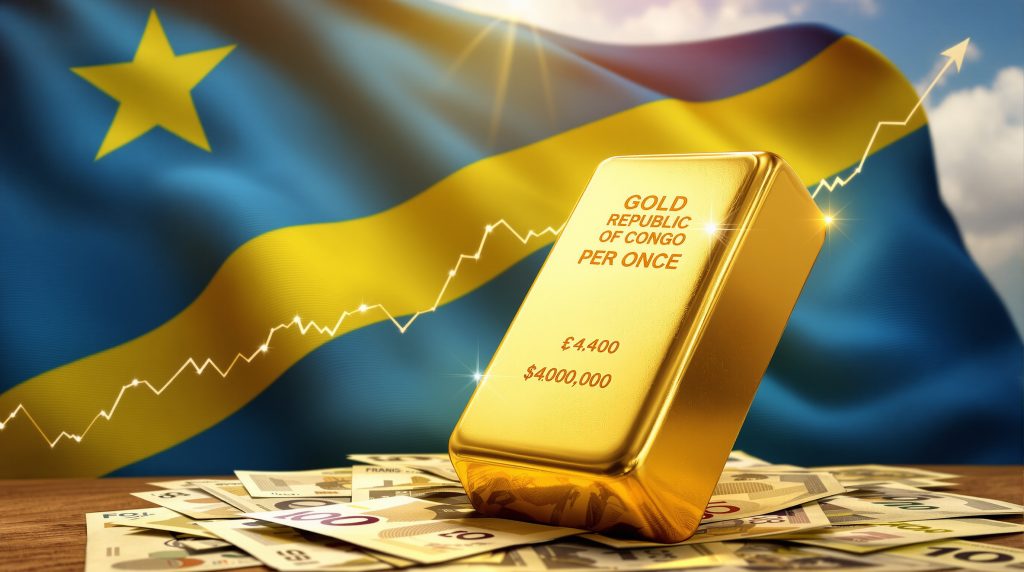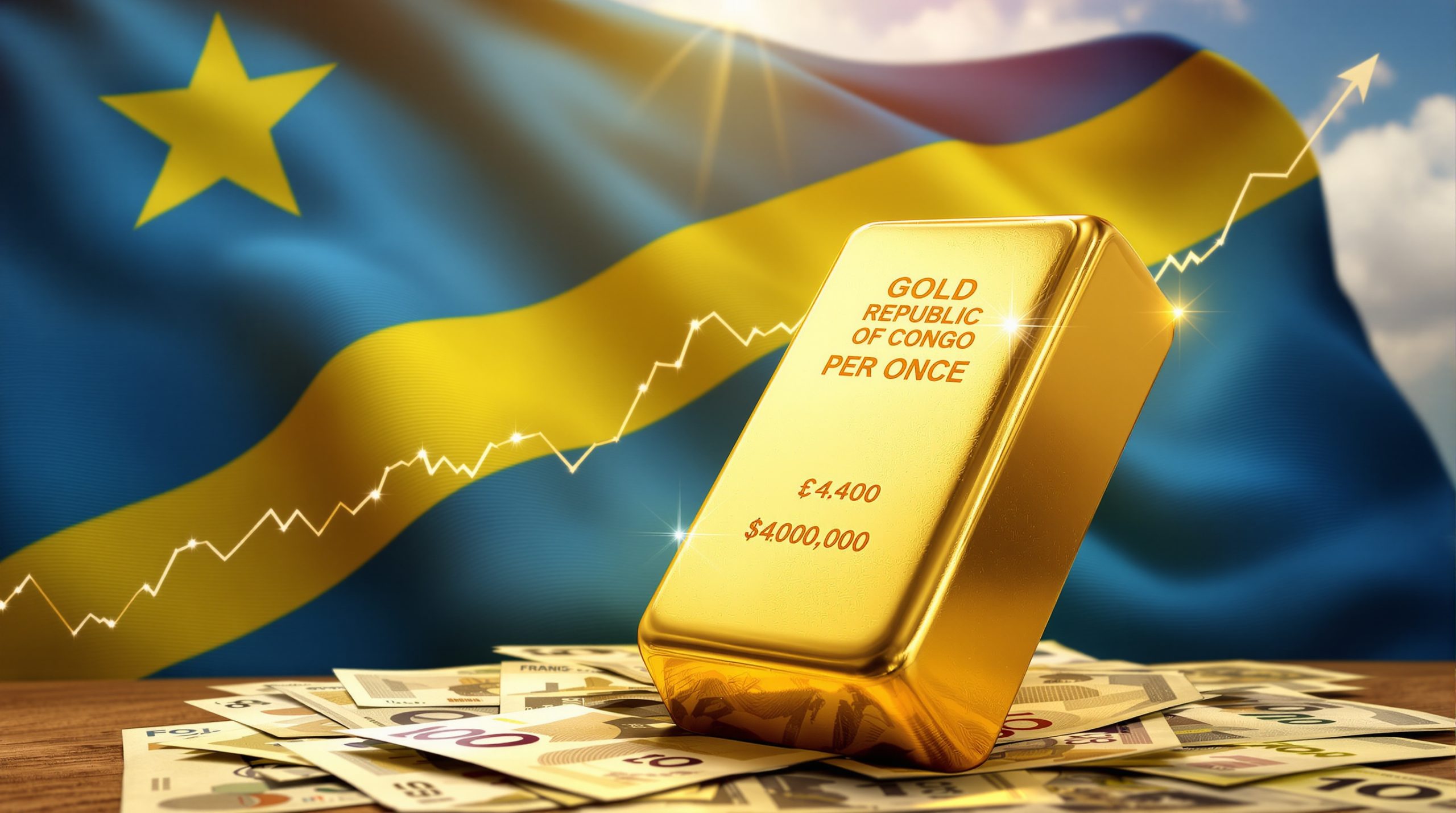Congo's Gold Reserves Initiative: Building National Wealth in a Surging Market
The Democratic Republic of Congo (DRC) has announced a strategic shift in its monetary policy, with plans to begin accumulating gold reserves for the first time despite being Africa's 10th largest gold producer. This initiative comes as global gold price highs have surged beyond $4,000 per ounce, reaching historic highs in October 2025. The Central Bank of Congo's decision represents a significant change in approach to managing the country's mineral wealth and economic stability.
Current State of Congo's Gold Reserves
Despite producing over 40 metric tons of gold annually, the DRC has historically maintained virtually no official gold reserves in its central bank. This disconnect between production and reserves has limited the country's ability to leverage its natural resources for economic stability and currency support. The absence of gold holdings has been particularly notable given the country's status as a significant gold producer on the African continent.
Why is Congo Building Gold Reserves Now?
Global Gold Price Surge
Gold prices have experienced an extraordinary rally in 2025, climbing more than 50% year-to-date and breaking through the $4,000 per ounce barrier in October. This dramatic price appreciation has created a compelling economic case for resource-rich nations to retain more of their precious metal production.
The current bull market in gold represents one of the strongest price environments in decades, giving Congo a timely opportunity to begin its reserves program during historically favorable market conditions.
Central Bank Buying Trend
The DRC joins a growing list of central banks worldwide that have been aggressively adding gold to their reserves. This global trend has seen central banks collectively purchase more than 1,000 metric tons in recent years, with many emerging economies leading the charge to reduce dependence on traditional reserve currencies like the US dollar.
This shift reflects a broader reassessment of reserve asset strategies among developing nations, with gold being viewed as a hedge against currency volatility and geopolitical uncertainty.
Currency Stabilization Strategy
According to Andre Wameso, who was appointed as head of the Central Bank of Congo in July 2025, building gold reserves will complement the bank's dollar holdings and potentially strengthen the Congolese franc on international markets.
The central bank has been implementing a coordinated monetary strategy, recently cutting benchmark interest rates while actively managing market liquidity. These measures, combined with the new gold reserve initiative, demonstrate a comprehensive approach to strengthening the nation's currency.
"That will not only reinforce the franc but also permit the franc to be traded internationally because it will be backed by reserves in gold, above and beyond dollar reserves," Wameso explained in a statement to Mining Weekly in October 2025.
What Are Congo's Gold Production Capabilities?
Current Production Profile
The DRC produces approximately 40 metric tons of gold annually, ranking it 10th among African gold producers according to the World Gold Council. However, this official figure likely understates the country's true production capacity due to widespread informal mining activities.
Industry experts estimate that significant quantities of gold go unreported each year, with much of this production flowing through informal channels that bypass official statistics and government revenue collection.
Formal vs. Informal Mining Sectors
The country's gold sector consists of both large-scale industrial operations and extensive artisanal mining networks. While formal mining operations contribute to official production figures, a significant portion of artisanal gold production is sold through informal channels, often crossing borders illegally.
This dual structure presents both challenges and opportunities for Congo's gold reserve initiative. While large-scale mining offers more immediate pathways for national gold acquisition, the vast artisanal sector represents an untapped resource that could significantly enhance reserve building if properly integrated into formal channels.
Production Challenges
Wameso acknowledged that much of the country's gold output from informal miners is sold illicitly via neighboring countries, financing conflicts rather than contributing to government revenue or economic development.
This leakage of valuable resources has long undermined Congo's ability to benefit fully from its mineral wealth. The artisanal mining sector employs hundreds of thousands of Congolese citizens but operates largely outside regulatory frameworks, creating challenges for formalizing production and redirecting gold flows to official channels.
"That gold should be the principal source of the development of our economy through financial solidity, monetary solidity of the central bank," Wameso stated in October 2025, though without detailing specific mechanisms to address the smuggling issue.
How Will Congo Implement Its Gold Reserve Strategy?
Acquisition Targets
When asked about the quantities of gold the central bank aims to acquire, Wameso ambitiously stated that "the sky is the limit." However, he did not provide specific targets or timelines for building these reserves, nor did he confirm whether the bank had already begun purchasing gold.
The absence of quantitative targets suggests the central bank may be taking a flexible approach, potentially allowing it to adjust acquisition strategies based on gold market trends and domestic production capabilities.
Monetary Policy Coordination
The central bank's gold reserve initiative coincides with other monetary policy adjustments. The bank recently cut its benchmark lending rate in early October 2025 and has indicated further easing may follow if inflation continues its downward trend. This coordinated approach suggests a comprehensive strategy to strengthen the Congolese franc.
By simultaneously building gold reserves while implementing accommodative monetary policy, the central bank appears to be pursuing a balanced approach that aims to support economic growth while enhancing currency stability.
Liquidity Management
Wameso noted that the central bank has been actively managing market liquidity, which has created favorable conditions for building foreign exchange reserves, including gold:
"That will help us because now the banks are looking for francs and we have them and therefore we are reconstituting our reserves of dollars by buying dollars for less on the market," he explained in the October 2025 statement.
This strategic management of local currency liquidity appears to be creating advantageous conditions for foreign currency acquisition, potentially providing a model for efficient gold reserve building as well.
How Does This Compare to Other African Nations' Gold Strategies?
Regional Gold Reserve Initiatives
Congo's move follows similar initiatives by other African nations seeking to leverage their mineral wealth through central bank gold holdings:
-
Ghana has implemented an active domestic gold buying program through its central bank
-
Tanzania has established gold reserves through government-mandated sales to its central bank
-
Nigeria has been steadily growing its reserves by purchasing from domestic production
-
Zimbabwe launched its gold-backed ZIG currency in 2024, representing one of the most ambitious gold-based monetary initiatives on the continent
-
Rwanda has established a strategic acquisition program for building gold reserves
-
Burkina Faso has implemented a domestic purchasing initiative to add to its reserves
-
Namibia has begun taking initial steps toward establishing a gold reserve framework
-
Kenya and Uganda are conducting feasibility studies and preliminary discussions on similar programs
Continental Integration Benefits
Wameso suggested that building gold reserves will complement Congo's participation in regional trade initiatives like the African Continental Free Trade Area, potentially strengthening both domestic economic stability and cross-border commerce.
The integration of stronger, resource-backed currencies could potentially enhance intra-African trade by reducing reliance on external currencies for regional commerce. This aligns with broader continental efforts to strengthen economic sovereignty and reduce vulnerability to external financial shocks.
What Economic Challenges Does Congo Face?
Budget Pressures
The DRC's national budget has faced significant strain in 2025 due to escalating conflict in the mineral-rich eastern regions. Wameso confirmed that additional expenditures, particularly in defense, have pressured government finances despite the country's mineral wealth.
The ongoing security situation in eastern Congo represents one of the most significant challenges to economic stability and resource governance. The conflict not only increases government expenditures but also complicates efforts to secure mining areas and formalize gold production.
IMF Concerns
The International Monetary Fund, which maintains a lending program with Congo, has expressed concern about the government's failure to meet budget deficit targets. The IMF has urged Congo to build adequate foreign exchange reserves, which the new gold initiative may help address.
The IMF relationship adds another dimension to Congo's monetary policy considerations, as the government must balance domestic priorities with the conditions and expectations associated with international financial support.
Poverty Despite Mineral Wealth
Despite being a major producer of cobalt, copper, and gold, the DRC remains among the world's poorest countries, highlighting the challenges of translating natural resource wealth into broad-based economic development.
This "resource paradox" has long characterized Congo's economic situation, where vast mineral wealth coexists with extreme poverty and underdevelopment. The gold reserve initiative represents one potential path toward better leveraging the country's natural resources for sustainable economic development.
What Are the Potential Benefits of Gold Reserves for Congo?
Currency Stability
Gold reserves could help stabilize the Congolese franc against international currency fluctuations, potentially reducing import costs and inflation pressures over time. A more stable currency could benefit businesses and consumers by creating a more predictable economic environment.
Historical analysis of countries with significant gold reserves suggests they often experience less currency volatility during periods of global financial stress, which could provide Congo with greater economic resilience.
Economic Sovereignty
By building gold reserves, Congo may reduce its dependence on external financial support and gain greater autonomy in monetary policy decisions. This increased policy independence could allow the government to pursue development strategies more closely aligned with domestic priorities.
Financial analysts note that countries with substantial gold reserves often have greater flexibility during economic crises, as they can leverage these assets to maintain stability without resorting to external assistance with potentially restrictive conditions.
International Trade Positioning
Gold-backed reserves could enhance Congo's position in international trade negotiations and potentially improve its credit rating and borrowing terms on global markets. A stronger reserve position might translate into lower borrowing costs and better access to international capital.
Credit rating agencies typically view substantial gold reserves favorably when assessing sovereign risk, which could potentially improve Congo's standing in international financial markets.
Domestic Resource Retention
A successful gold reserve program could create incentives to formalize more of the country's gold production, reducing smuggling and keeping more of the economic benefits within national borders. This formalization could generate additional government revenue while potentially improving working conditions in the mining sector.
By creating reliable domestic markets for gold at competitive prices, the central bank could help redirect gold flows from illegal channels toward formal systems that contribute to national development.
What Implementation Challenges Might Congo Face?
Securing Supply Chains
Establishing reliable domestic supply chains to direct gold from mines to the central bank will require addressing deeply entrenched informal networks and smuggling operations. This challenge involves not only logistical considerations but also complex social and economic factors that have sustained informal mining for generations.
The integration of artisanal miners into formal supply chains represents a particularly challenging aspect of implementation, requiring thoughtful approaches that balance regulatory objectives with livelihood considerations.
Security Concerns
The ongoing conflict in eastern Congo, where much artisanal gold mining takes place, presents significant security challenges to formalizing the sector and securing gold for national reserves. Military operations and armed group activities frequently disrupt mining operations and complicate government efforts to establish control.
Securing mining areas and transportation routes will require coordinated security strategies that address both immediate threats and underlying conflict drivers.
Governance and Transparency
Effective implementation will require robust governance mechanisms to ensure transparency in gold acquisitions and reserve management, particularly given historical challenges with resource governance in the mining sector. Establishing clear procurement protocols, verification systems, and public reporting will be essential.
International standards such as the Extractive Industries Transparency Initiative (EITI) provide potential frameworks for ensuring accountability in reserve building operations.
Market Dynamics
As a relatively small player in global gold markets, Congo will need to carefully manage its purchasing strategy to avoid driving up local prices or creating market distortions. Strategic timing of acquisitions and diversified sourcing approaches could help mitigate these risks.
The central bank may need to develop sophisticated market analysis capabilities to optimize its gold investment strategies in the context of volatile global prices and local production patterns.
A New Chapter for Congo's Mineral Wealth?
The DRC's decision to build gold reserves marks a potentially transformative shift in how the country manages its natural resources. By retaining more of its gold production for national reserves, Congo aims to strengthen its currency, enhance economic stability, and potentially improve its position in global markets.
While significant challenges remain—from securing supply chains to addressing smuggling and conflict financing—the initiative represents an important step toward greater economic sovereignty and more effective utilization of the country's mineral wealth.
As record‐high gold prices continue their upward trajectory and central banks worldwide increase their gold holdings, Congo's timing may prove advantageous. However, the success of this initiative will ultimately depend on effective implementation, governance, and coordination with broader economic development strategies.
African Nations' Gold Reserve Initiatives
| Country | Current Status | Implementation Approach |
|---|---|---|
| Congo (DRC) | Beginning reserve building program | Central bank to acquire domestic gold production |
| Ghana | Active gold buying program | Central bank purchases from local miners |
| Tanzania | Established reserves | Government mandated sales to central bank |
| Nigeria | Growing reserves | Purchasing domestic production |
| Zimbabwe | Gold-backed currency (ZIG) | Reserves support national currency |
| Rwanda | Building reserves | Strategic acquisition program |
| Burkina Faso | Adding to reserves | Domestic purchasing initiative |
| Namibia | Initial steps toward reserves | Planning acquisition framework |
| Kenya | Exploring options | Feasibility studies underway |
| Uganda | Considering program | Preliminary discussions ongoing |
Disclaimer: This article contains forward-looking statements about Congo's gold reserves strategy and potential economic outcomes. Future results may differ materially from those anticipated due to various factors including market conditions, implementation challenges, and geopolitical developments. Readers should consider this analysis as informational rather than as financial advice.
The recent surge in gold prices beyond $4,000 per ounce creates a compelling backdrop for Congo's initiative. However, building effective gold reserves requires more than favorable market conditions—it demands institutional capacity, governance frameworks, and strategic implementation plans that address the complex realities of Congo's gold sector.
For Congo to truly transform its relationship with gold from mere production to strategic reserve asset, it will need to overcome significant challenges in formalization, security, and governance. Yet the potential benefits—including currency stability, economic sovereignty, and enhanced international standing—make this ambitious initiative worthy of careful consideration and support.
The current gold price forecast suggests continued strength in the precious metals market, potentially providing favorable conditions for Congo's reserve-building efforts in the coming years.
Ready to Catch the Next Major Gold Discovery?
Discover significant ASX gold exploration opportunities as they emerge with Discovery Alert's proprietary Discovery IQ model, which transforms complex mineral announcements into actionable insights for traders and investors. Visit our discoveries page to understand why major mineral discoveries can lead to exceptional returns and begin your 30-day free trial today.




